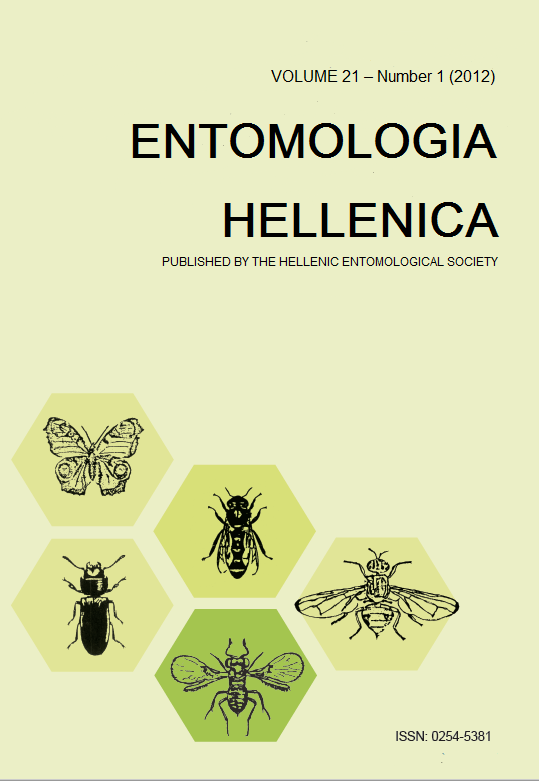Μη γραμμικά μαθηματικά πρότυπα για την περιγραφή της ανάπτυξης και της αναπαραγωγικής ικανότητας των αρπακτικών των ψευδοκκόκων Nephus includens και Nephus bisignatus
Περίληψη
Μεταξύ των μαθηματικών πρότυπα που χρησιμοποιούνται για την περιγραφή της ανάπτυξης και της αναπαραγωγικής ικανότητας των εντόμων, οι εξισώσεις των Enkegaard, Αναλυτή, Bieri 1 και Bieri 2 έχουν τη δυνατότητα να περιγράψουν και τα δύο βιολογικά χαρακτηριστικά. Στην παρούσα μελέτη αυτές οι εξισώσεις χρησιμοποιήθηκαν για να περιγράψουν την ανάπτυξη και την αναπαραγωγική ικανότητα δύο αρπακτικών των ψευδοκόκκων [Nephus includens (Kirsch) και Nephus bisignatus (Boheman) (Coleoptera: Coccinellidae)] επί Planococcus citri (Risso) (Hemiptera: Pseudococcidae) σε σταθερές θερμοκρασίες (15oC - 35oC)?. Όλες οι εξισώσεις είχαν καλή προσαρμογή στα δεδομένα. Ειδικά για την ανάπτυξη των ατελών σταδίων ο προσαρμοσμένος συντελεστής προσδιορισμού (R2 adj), το άθροισμα τετραγώνων του υπολοίπου (RSS) και το πληροφοριακό κριτήριο του Akaike (AIC) κυμάνθηκαν από 0,9908-0,9996, 0,0019-89,1752 (x10-4), και (-75,43) – (-31,07), αντίστοιχα. Η ιδανική θερμοκρασία ανάπτυξης (Topt) και το ανώτερο θερμοκρασιακό όριο (Tmax) υπολογίστηκαν ικανοποιητικά από όλες τις εξισώσεις. Η Topt κυμάνθηκε από 32,6- 34,0oC για το N. includens και από 30,0-30,6oC για το N. bisignatus. Η Tmax κυμάνθηκε από 35,0-38,8oC για το N. includens και από 33,1-36,0oC για το N. bisignatus. Το κατώτερο θερμοκρασιακό όριο (Tmin) υπολογίστηκε ικανοποιητικά από την εξίσωση Bieri-1 (11,0 και 10,0oC για το N. includens και για το N. bisignatus αντίστοιχα) ενώ υποεκτιμήθηκε από την εξίσωση Αναλυτή (8,0 και 4,9oC). Στα δεδομένα της γονιμότητας υπήρξε καλύτερη προσαρμογή στα δεδομένα που αποκτήθηκαν στους 25oC, δηλαδή κοντά στην ιδανική θερμοκρασία ανάπτυξης [όπου R2 , R2 adj, RSS και AIC κυμάνθηκαν από 0,8246-0,9704, 9,2729- 24,0736 και (-246,82) – (-115,34), αντίστοιχα]. Συμπερασματικά, διαπιστώθηκε ότι, από τα μη γραμμικά μαθηματικά πρότυπα που δοκιμάστηκαν, η εξίσωση Bieri-1 είναι η πιο κατάλληλη διότι μπορεί να υπολογίσει σωστά όλες τις ζητούμενες παραμέτρους (Tmin, Topt, Tmax) που αφορούν στην ανάπτυξη καθώς και να περιγράψει με ακρίβεια τη μεταβολή της ημερήσιας αναπαραγωγικής ικανότητας των δύο αρπακτικών.
Λεπτομέρειες άρθρου
- Πώς να δημιουργήσετε Αναφορές
-
Kontodimas, D. C. (2012). Μη γραμμικά μαθηματικά πρότυπα για την περιγραφή της ανάπτυξης και της αναπαραγωγικής ικανότητας των αρπακτικών των ψευδοκκόκων Nephus includens και Nephus bisignatus. ENTOMOLOGIA HELLENICA, 21(1), 13–24. https://doi.org/10.12681/eh.11514
- Τεύχος
- Τόμ. 21 Αρ. 1 (2012)
- Ενότητα
- Articles

Αυτή η εργασία είναι αδειοδοτημένη υπό το CC Αναφορά Δημιουργού – Μη Εμπορική Χρήση – Παρόμοια Διανομή 4.0.
Authors who publish with this journal agree to the following terms:
Authors retain copyright and grant the journal right of first publication with the work simultaneously licensed under a Creative Commons 4.0 license.
Authors are able to enter into separate, additional contractual arrangements for the non-exclusive distribution of the journal's published version of the work (e.g. post it to an institutional repository or publish it in a book), with an acknowledgement of its initial publication in this journal. Authors are permitted and encouraged to post their work online (preferably in institutional repositories or on their website) prior to and during the submission process, as it can lead to productive exchanges, as well as earlier and greater citation of published work.



